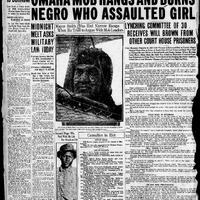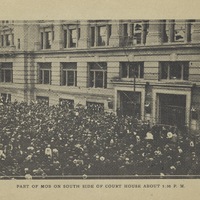More Than a Snapshot: Will Brown's Lynching and the Violence of History
Summary
On September 25, 1919, a white couple in Omaha accused a Black man, Will Brown, of holding them up and sexually assaulting the woman. Brown was subsequently arrested and taken to the courthouse. As news of the alleged assault spread, a group of people marched from the Bancroft School in South Omaha to the Douglas County Courthouse, where Brown was being held. By four or five p.m., a crowd of around 10-15,000 people had gathered outside the courthouse. From there, the courthouse was set on fire, people scaled the exterior of the courthouse, cut fire hoses when firefighters tried to put out the blaze, and, ultimately, Will Brown was lynched.
When Omaha Mayor Edward Smith tried to intervene, rioters beat him and attempted to hang him from a traffic light before police were able to remove the rope from his neck and save his life. Members of the mob broke into Brown’s cell in the burning courthouse, forced him into the street, and lynched him from a pole at the corner of 18th and Harney streets. His murderers then assaulted his body with gunfire, dragged him through the street with a stolen police car, before setting fire to his body at the intersection of 17th and Dodge streets. The lynch mob was heavily photographed, including a now infamous snapshot of the crowd grinning in front of Brown’s burning body. Federal troops eventually arrived in the wee hours of the morning and the rioters dispersed. Will Brown’s remains were buried days later in an unmarked grave in Potter's Field Cemetery. No one was ever held accountable for Brown’s lynching.
The Red Summer of 1919 saw widespread movements of racial violence across the United States while also witnessing the emergence of the New Negro Movement and a new idea of self-determination with the Treaty of Versailles. It was also the era of yellow journalism and labor antagonism. There was widespread xenophobia.
The Midwest often considers itself separate from the history of the racial violence of the Jim Crow Era, but instances of violence per the number of Black people in the Midwest is similar to the ratio of racialized violence in the South. With the 100-year anniversary of Will Brown’s lynching in 2019 coinciding with the eruption of a new wave of racial equality protests in 2020, the memory of the Midwest’s long history of xenophobia remains important. The ideas presented by the 13th, 14th, and 15th Amendments remain significant, and they continue to be challenged.
Suggested Reading
Howard, Ashley. Midwest Unrest: 1960s Urban Rebellions and the Black Freedom Movement. University of North Carolina Press, 2025.
Menard, Orville D. "Lest We Forget: The Lynching of Will Brown, Omaha's 1919 Race Riot," Nebraska History 91 (2010): 152-165. [Contains disturbing images. Use caution.]
Omaha's Riot in Story & Pictures. Educational Publishing Company, 1919. [Contains disturbing images. Use caution.]
- Title
- More Than a Snapshot: Will Brown's Lynching and the Violence of History
- Description
- This teaching module discusses the history of racial violence in the Midwest, featuring a webinar with Ashley Howard, author of the 2025 book, Midwest Unrest: 1960s Urban Rebellions and the Black Freedom Movement.
- Contributor
- Professor Ashley Howard, University of Iowa
- Documents
-
 Webinar - More Than a Snapshot: Will Brown's Lynching and the Violence of History (2025)
Webinar - More Than a Snapshot: Will Brown's Lynching and the Violence of History (2025)
-
 The Lynching of Will Brown (1919)
The Lynching of Will Brown (1919)
-
 Omaha's Riot in Story & Pictures (1919)
Omaha's Riot in Story & Pictures (1919)
-
 Omaha Grapples with its Ugly Past (2019)
Omaha Grapples with its Ugly Past (2019)
-
 Remembering a dark past, renewing resolve for the future (2019)
Remembering a dark past, renewing resolve for the future (2019)
- Subject
- African Americans
- Title
- More Than a Snapshot: Will Brown's Lynching and the Violence of History
- Description
- This teaching module discusses the history of racial violence in the Midwest, featuring a webinar with Ashley Howard, author of the 2025 book, Midwest Unrest: 1960s Urban Rebellions and the Black Freedom Movement.
- Contributor
- Professor Ashley Howard, University of Iowa
- Documents
-
 Webinar - More Than a Snapshot: Will Brown's Lynching and the Violence of History (2025)
Webinar - More Than a Snapshot: Will Brown's Lynching and the Violence of History (2025)
-
 The Lynching of Will Brown (1919)
The Lynching of Will Brown (1919)
-
 Omaha's Riot in Story & Pictures (1919)
Omaha's Riot in Story & Pictures (1919)
-
 Omaha Grapples with its Ugly Past (2019)
Omaha Grapples with its Ugly Past (2019)
-
 Remembering a dark past, renewing resolve for the future (2019)
Remembering a dark past, renewing resolve for the future (2019)
- Subject
- African Americans